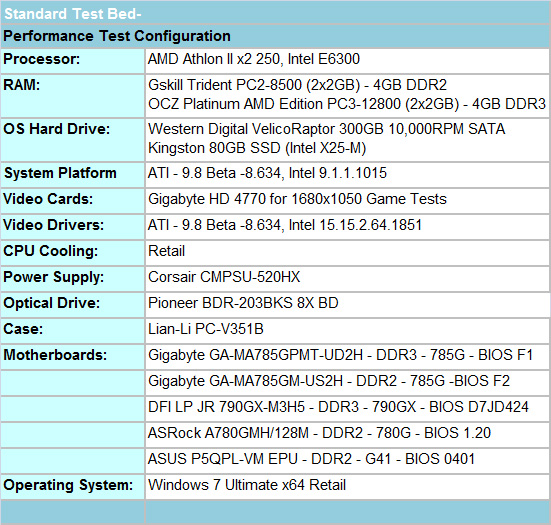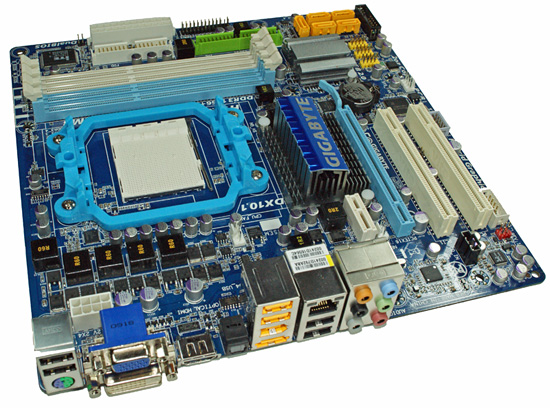AMD's 785G Chipset - Revolutionary or Evolutionary?
by Gary Key on August 4, 2009 5:00 AM EST- Posted in
- Motherboards
Test Setup -

Our primary board for testing today is the Gigabyte GA-MA785GPMT-UD2H that features DDR3 memory support along with 128MB of SidePort memory. We selected the Gigabyte HD 4770 video card for our discrete graphics card duties. The WD VelociRaptor 300GB is our hard drive of choice for secondary storage purposes, while Kingston’s 80GB (Intel X25-M) SSD is our primary drive choice. Pioneers’s BDR-203BKS Blu-ray playback capable drives fills in for optical duties. We purchased OCZ’s impressive DDR3-1600 C7 AMD 4GB kit for DDR3 memory duties along with GSkill’s Trident DDR2-1066 C5 4GB kit. We chose the retail coolers for our standard results.
Our power supply choice is the excellent Corsair 520HX, and considering our standard test bed is limited to a single video card this power supply works perfectly. Our case choice is the Lian-Li PC-V351B. We utilized the ASUS VH242H 23.6" 1920x1080 LCD monitor for display duties. Finally, we have dropped Vista 64-bit for good and moved to the Windows 7 64-bit Retail release for our testing today - it just works better.

There are several 785G motherboards available for sale as of today with additional models arriving at various resellers over the next two weeks. We just received several boards from MSI, ASRock, ECS, ASUS, Gigabyte, Biostar, and Foxconn that will be part of an 785G roundup next week. In the meantime, for the more performance oriented crowd we highly suggest you take a look at our primary board from Gigabyte today or the ASUS M4A785TD-V EVO and MSI 785GM-E65. Prices for the 785G products should range from $75 up to $100 depending on the model and features.










43 Comments
View All Comments
Shadowmaster625 - Wednesday, August 5, 2009 - link
Since when have intel integrated graphics been in the same ballpark as the 7xx? Before today, every benchmark I saw AMD beat Intel by about 50-200% (Without overclocking or sideport crap.) Now all the sudden many of these benchmarks are showing an edge of only 20%, and this is comparing the 785G vs the G41. What is going on here? I think you need to do a more detailed review and comparison vs Intel's topline model, GMA 4500MHD(?) and nvidia 9300 as well.TA152H - Tuesday, August 4, 2009 - link
This could have been summed up in a simple paragraph, instead of page after page of nothing. Still, I guess you have to prove the points.It's pretty disappointing, really. The chipset doesn't represent a clear advantage over the 790GX, despite the author's best effort to distort facts and compare a overclocked 785 with a nominally clocked 790GX. It's always annoying when an author already has an idea of what he wants to present, and then finds way to do it. Better to go with an open mind and let readers make up their own mind.
The same applies with the G41. Another lame attempt by the author to distort the article to make a preconceived point. Since you show the 790GX, shouldn't you show the G45? Guess not, it might make the pre-conceived purpose of the article less clear.
AMD makes a crappy processor compared to Intel, not a pretty good one. Everything is relative. It's really a zero sum game. So, we have GREAT (Nehalem), VERY GOOD (Penryn), and PRETTY GOOD (AMD). Where's the bad? What's pretty good compared to? What's it better than. It's the worst of the three lines, even compared to Intel's last gen. In other words, AMD has the bad. Someone has to do it. Not everyone can be 99 percentile. Someone's got to be 1 percentile for the 99 percentile folk to exist. Not that Nehalem is 99, and AMD is 1. Probably more like 80 and 20. AMD processors are still usable, for sure, and I still think make good packages because of their superlative chipsets, but the processor on it's own merit has no reason to exist, except within this context and that of competition. It's worse than Nehalem at everything, by a lot, and is the same size. That's not pretty good, it's pretty bad.
bruce24 - Friday, August 7, 2009 - link
re: "The same applies with the G41. Another lame attempt by the author to distort the article to make a preconceived point. Since you show the 790GX, shouldn't you show the G45? Guess not, it might make the pre-conceived purpose of the article less clear."I was also wondering why he would only show the G41. In the article he says "The direct price competitor", but if I go to newegg.com, I can find multiple G45 boards in the same price range as the 785G.
Spoelie - Tuesday, August 4, 2009 - link
Would just like to chime in on some test subjects that are left untouched*Is UVD decoding still limited to AVC profile L4.1 (the one used in bluray)? The competition (nvidia) fully supports profile L5.1, which ensures that they can accelerate *every* video. With ATi it's either hit or miss, there are videos out there that use it.
*ATi has serious issues with their SATA implementation, mainly AHCI mode.. are they fixed in SB710? I'm thinking not. Refer to your colleagues at techreport..
SB600: http://www.techreport.com/articles.x/13832/5">http://www.techreport.com/articles.x/13832/5
SB700: "We quite literally see more of the same in the SB700's Serial ATA controller. The port count here is up to six, but they're basically six of the same ports you get on the old SB600" -> http://www.techreport.com/articles.x/14261/10">http://www.techreport.com/articles.x/14261/10
SB750: "Unfortunately, AMD's longstanding issues with AHCI Serial ATA controller configurations persist in the SB750, all but forcing users to run the south bridge in plain old IDE mode. That's not the end of the world, but IDE mode doesn't support Serial ATA perks like hot swapping and Native Command Queuing." -> benchmarks in following link are IDE mode -> http://www.techreport.com/articles.x/15256/8">http://www.techreport.com/articles.x/15256/8
cghebert - Tuesday, August 4, 2009 - link
The comments in TR's 785g review can shed some light on your SB AHCI questions:Comment by Prototype:
"I think it's a non-issue. The out-of-box Windows 7 and Vista AHCI drivers work just fine with the southbridge, it's just the vendor drivers from AMD (and bundled by the motherboard vendors) that cause subpar performance.
Which you can avoid by, you know, just not installing them.
It's not like they add any functionality you don't already have by using Microsoft's excellent driver. In my experience Microsoft's generic drivers tend to be more stable and less buggy than vendor drivers anyway, a result of the fact that hardware vendors couldn't write decent software to save their lives, not even Intel.
The hidden issue is the CPU utilization of the USB drivers, really. Note how both SB710 boards use 4 times as much CPU time as the ICH7 USB driver.
As far as ICH7 AHCI is concerned, Intel doesn't have support for AHCI in their ICH7 "Base" driver, but if the motherboard manufacturer exposes AHCI in the BIOS, Windows Vista and 7's generic AHCI driver by Microsoft can be used for the device. (And for Windows XP, the Intel AHCI driver's .inf can be modified to add the PCI product ID and loaded during the installation process.)"
There is more information in the comments if you want to check into it further.
mmaenpaa - Tuesday, August 4, 2009 - link
It seems that this feature is mostly forgotten. Even AMD/ATI is not talking too much about it. I do remember testing it maybe a year ago with X1250 chipset and there were too much problems (yeah, I did try to find a solution, but it propably would have taken more than 10 minutes, so I gave up :-).Now, just last week I tested with Gigabyte 780G mb and HD 4670 PCIE card and it simply worked. I had three monitors connected (XP PRO).
I do believe this is quite a nice feature and if you are using ATI cards it is practically free.
Markku
HollyDOL - Tuesday, August 4, 2009 - link
Hmm, no clue why, but despite what author says, both movie screenshots for Intel/AMD solutions look almost exactly same (difference being they are not the same frame). Is it just due to JPEG picture quality loss or the difference between AMD/Intel playback is practicaly uncomparable?Viewed on Eizo FlexScan panel, so there shouldn't be any quality reductions on my screen...
MrCommunistGen - Tuesday, August 4, 2009 - link
I would have liked to have seen some SB700 (on the 780G) vs SB710 (on the 785G) benches on the USB/HD benchmarks.Kibbles - Tuesday, August 4, 2009 - link
On page 6, the 4th graph is a duplicate of the 3rd.JarredWalton - Tuesday, August 4, 2009 - link
Fixed, thanks.